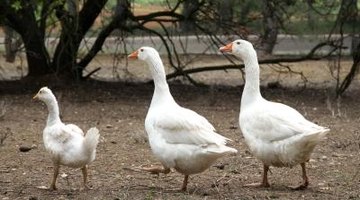The Specifications for a Goose Fence
Whether you're looking for a fence to keep your geese in, or to keep wild geese out, a relatively low and simple construction should fulfill your needs. If you're raising your own fowl, keep in mind that geese are rather pugnacious birds, fearless before a range of potential predators, and with a tendency to roam. Nonetheless, a well-placed fence of the right dimensions effectively can dissuade your own geese from straying and keep wild geese from entering your property.
A Basic Low Fence

The primary means of keeping your own geese from roaming is scattering feed for them every evening. In addition, you can use a basic fence to avoid undue wandering during the days. Build the fence 24 to 36 inches tall. Because domestic geese seldom fly, the low fencing will be plenty. For an inexpensive, simple and temporary solution, poultry netting strung between stakes will be sufficiently sturdy to corral most geese. If you plan to keep geese for many years, you certainly can provide a more weather-proof fence made of wood, wire or other material. If foxes tend to roam nearby, you can use electrified fencing to keep them from entering. Generally, geese will defend themselves readily from lesser predators, such as local dogs and cats.
Fencing Out Wild Geese
If wild geese, such as the migratory Canada goose, regularly disturb your lawn or plantings, you can keep them from entering your property with a couple of different fence designs. An electrified fence effectively will keep out Canada geese as soon as they discover the slight shock it delivers. Because wild geese problems only arise for a short period each year, in most locations, you can opt for portable electrified fencing that's easy to assemble and take down. The electrified fence should have a 120-volt or battery-operated energizer. You can use a "low impedance energizer," which delivers short bursts of power, 4000 volts to be precise, every second. Such energizers are completely safe to fowl, delivering discomfort but no injury. The fencing generally uses 1/2 inch polytape, made of polyethylene embedded with wires, to carry the charge. Set up two strands of tape, one at a height of 8 inches and the other at 18 inches. Generally the grounding rods are 6 feet tall; set them at approximate 12 foot intervals. If you live near a body of water, simply set a 1- to 2-foot, nonelectrified fence around its perimeter. This will dissuade Canada geese from visiting the area.
Fencing for Goslings
While your goslings are still young, but beginning to stay outdoors, you'll need to give them slightly better protection from any local predators, including dogs. As for full-grown geese, a fence of no more than 36 inches high will be sufficient. Set up the pen or run in an area you need weeded. A strawberry patch makes an excellent space for goslings; just remove them before the fruit begins to ripen. At night, always bring the goslings indoors.
References
Writer Bio
Danielle Hill has been writing, editing and translating since 2005. She has contributed to "Globe Pequot" Barcelona travel guide, "Gulfshore Business Magazine," "Connecting Lines: New Poetry from Mexico" and "The Barcelona Review." She has trained in neuro-linguistic programming and holds a Bachelor of Arts in comparative literature and literary translation from Brown University.
Photo Credits
- Jupiterimages/Photos.com/Getty Images
More Articles



